No Results Found
The page you requested could not be found. Try refining your search, or use the navigation above to locate the post.
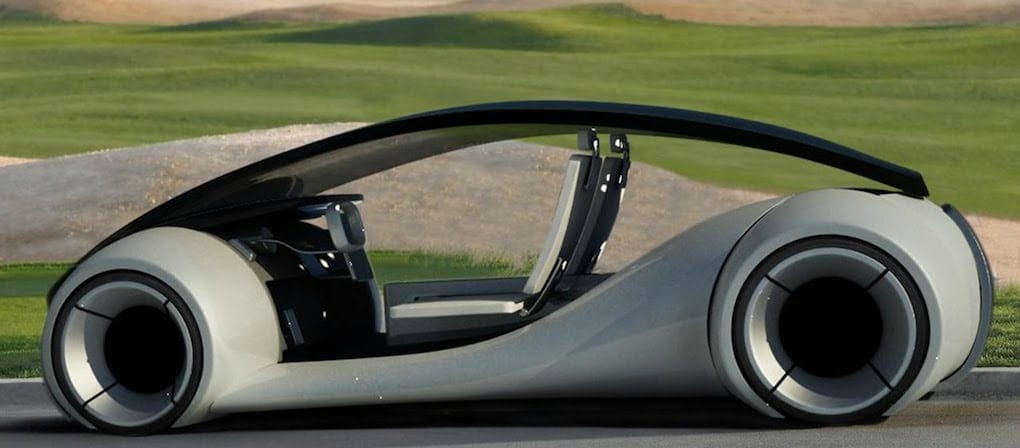
Aside from Chinese automakers most auto brands from the East have been slow or hostile towards the electric vehicle revolution, either succumbing to hydrogen-based cars prescribed by the dominant Toyota which holds a stake in some auto manufacturers in the East. This week we saw some of them revealing their EV strategies.
One of the last international brands to join the race to develop electric vehicles, Subaru, lifted the lid further on its electrification plans this week. The Japanese Times reported that Subaru would introduce a series of pure electric vehicles produced at its Guma Prefecture for the Japanese market from 2021 according to a source. According to the JT Subaru will also introduce PHEV versions in the USA from 2018 to comply with regulations in its largest market outside of Japan. It is expected that the company will bring PHEVs of the Legacy Outback, Forester SUV, and Impreza sedan to the USA as the carmaker now pins its hopes on EVs to boost its struggling brand image. Subaru which has won various awards for safety despite a recent scandal related to breaches in its final inspection department. To save development costs, the company is considering joining the recently created partnership between Toyota and Mazda to develop EV tech.
Renault Samsung Motors (RSM) unveiled the 2018 Renault Samsung SM3 Z.E. at the Daegu International Future Auto Expo this week. The 2018 Samsung SM3 ZE is based on the Renault Fluence Z.E. which has been discontinued in Europe in 2016. The locally assembled Samsung SM3 Z.E received a battery upgrade from 22kWh to 36kWh delivering an extended range of 132 miles (213km). The 2018 model is available at a pre-release price 41.5 million SK Won, which is in the region of $38,000, on order. Sales for the Samsung SM3 Z.E. totaled around 3,500 units since its release in 2013 with reports saying that the Ministry of Health purchased 1,200 units earlier the year. According to the statement of the company, the Samsung SM3 has an autonomy of 5 days based on the average commute in South Korea of around 40km per day (25 miles).

Indian automaker Tata and city-based Jayem Automotives joined forces to revitalize the loss-making Tata Nano with an electric powertrain. The Tata Nano EV will be branded under the NEO brand. Electra EV (Electrodrive Powertrain Solutions Private Limited) will provide the powertrain, Tata will supply the components, assembly and distribution will be done by Jayem Auto. The Tata Nano EV had some failed starts since 2010. The 4-seat 48-volt NEO Nano with its 17kW electric motor has a range of 200km (ARAI test cycle) or 150km with its aircon on. The NEO Nano is expected to be released soon but will at first only be available to Indian raid-hailing company, Ola Cabs.
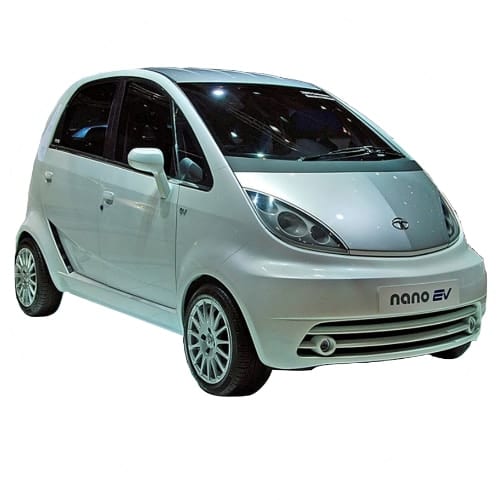
Volvo and controversial raid-hailing company Uber entered into a $300 million partnership in August 2016 to develop robo-taxis built on Volvo’s fully modular Scalable Product Architecture (SPA). This week the two companies went further with the signing of a non-exclusive framework agreement whereby Volvo will supply 24,000 self-driving cars to Uber from 2019 to 2021. Volvo developed the XC90 SUV with the help of Uber to fulfill the requirements specified for the ride-hailing application. Uber will supply its own self-driving technology while Volvo would be free to add its own autonomous tech for its own use. Volvo is expected to release its first fully autonomous car only in 2021.
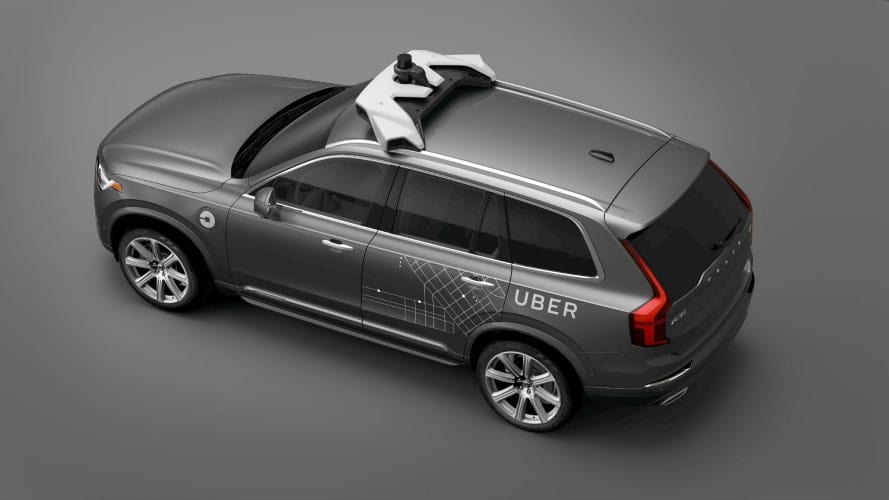
BMW USA issued a stop-sell of new BMW i3 EVs and recall of all BMW i3 models sold in the country from 2014 to 2018. The call-back only affects BMW i3’s in the USA due to the iconic electric car not complying with the stringent National Highway Safety Administration’s safety specifications. The recall will affect over 30,000 BMW i3’s out of nearly 100,000 sold worldwide. The BMW i3 and i3 REx failed to meet the specifications in a frontal crash test for female’s with a height of 1.51 (5 feet) meters and weighing 50kg (110 pounds) not wearing safety belts. Such an eventuality might sound absurd especially in countries where the wearing of safety belts is required by law. However, in the USA state of New Hampshire, the wearing of safety belts is not enforced by law. Compliance tests by BMW came in below the threshold but are inconsistent with the transport agency’s test leaving the problem unresolved for the moment with no immediate solution.
A report by Green Car Reports claimed that Ford has stopped producing the Ford C-Max Energi PHEV. Sales for the underperforming Ford C-Max Energi, launched in 2012, have plateaued after 2015 with a total of 41,000 units sold in the USA up to October 2017, contributing nearly 6% of all EVs sold in the country. The Ford C-Max Energi PHEV is also sold in Canada and was for a brief period introduced to the Dutch market back in 2015. Ford has undergone two strategy changes in the last year and is under pressure to cut cost and catch-up with its competitors in the EV race.
For long Apple has kept its self-driving program under wraps causing many to think that the company is losing the race against its competitor Google and the rest of the market. Apple’s secretive autonomous project named Project Titan received a permit to test its systems on three 2015 Lexus RX450h cars on California’s public roads in April 2017.
According to Reuters researchers at Apple developed a system only using Lidar to detect cyclists and pedestrians. The report by researchers Yin Zhou and Oncel Tuzel was published in the independent online journal arXiv. According to the paper, Apple developed a system called “VoxelNet” which uses fewer sensors and is more effective in detecting three-dimensional objects. To date, autonomous systems used a combination of camera’s and Lidar to view the world around the car.
Previous reports claimed that Apple set itself a deadline of 2017 to prove the feasibility to produce an autonomous driving system. The cover picture shows one of the prototypes associated with Apple’s Project Titan.
The page you requested could not be found. Try refining your search, or use the navigation above to locate the post.
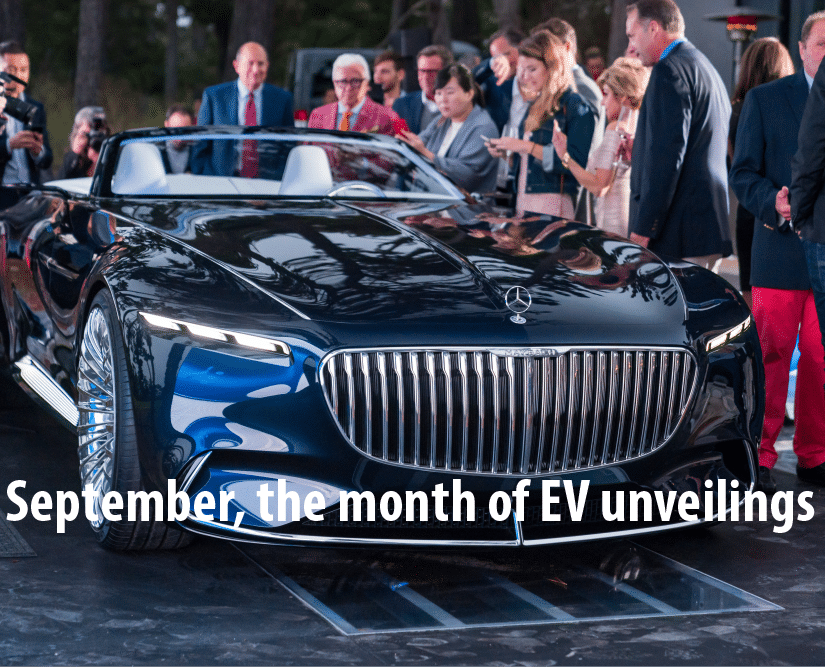
The EV sector is expected to hot up in the last quarter of 2017 as we near 2018, with some long awaited new EVs to being unveiled or upgrades of existing models introduced.
This week saw Mercedes unveiling it’s Vision Mercedes-Maybach 6 Cabriolet at the prestigious Pebble Beach Concours d’Elegance. The 80kWh concept EV has a range of over 500km (NEDC) and a drive system with a 550kW output. The ultra luxurious six-meter long concept vehicle is designed to anticipate the needs of its passengers and to provide the required information and solutions in real time.

As we enter September in the coming week we look forward to the release/unveiling of the following Evs:

World leading research and education group, WMG, the University of Warwick, and design company Astheimer unveiled a lightweight prototype delivery vehicle, the DELIVER-E this week. According to a press release by Warwick University advanced battery experts, at WMG fitted the vehicle with a powerful 48V 6.5kWh battery system, increasing its peak power from 12 kilowatt to 36 kilowatt – helping it to cope with an increased weight of goods, and to conserve energy despite the start-stop nature of deliveries. DELIVER-E will be showcased as a demonstrator, at a number of events through the year. WMG and collaborative partners will also use it when undertaking research around electric vehicles.
The Indian SOE (State Owned Enterprise), Energy Efficiency Services (EESL) called for international auto companies to bid to supply 10,000 EV sedans, starting with 1,000 that would be used by government departments. The winning bid should be able to provide an EV with a 150km (94 miles) range. EESL also called for bids to 4,000 charging points. India is trying to fast track the use of EVs through its National Electric Mobility Mission Plan. The plan which has a first target of 400,000 EVs by 2020 battles to gain momentum. Local manufacturers Tata and Mahindra Mahindra has been slow to supply EV models due to economic viability and low subsidy support from the Indian Government. An incentive scheme was introduced in April 2017 as part of the Faster Adoption and Manufacturing of Electric Vehicles (FAME) program.
The UK company, ULEMCo, this week announced that it developed a fuel cell range extender module for the Nissan e-NV200 MPV. The module will extend the range of a fully laden delivery vehicle by 240km (150 miles).
The scientific journal, Nature Communications, this week published a paper on a breakthrough in Magnesium rechargeable batteries, delivering an energy density of 400 mAh/g. According to the paper magnesium, an abundant metal, have the potential to offer high-energy density, safety, and low cost. Researchers found a way to overcome a stumbling block in the technology by altering the design a magnesium battery cathode.
Skoda Auto DigiLab and its Israeli commercial partner, Champion Motors agreed to open a technology center in Tel Aviv to collaborate with start-ups and universities on emerging automotive tech.
WM Motors, China’s Tesla, and German sports-car design company, Isdera announced this week that it plans to partner on building EVs. WM Motors joins a list of Chinese automakers either partnering or establishing research facilities with Western companies and countries on EV development.
Ford and the Chinese automaker Anhui Zotye this week announced the signing of a Memorandum of Understanding to establish a 50/50 JV to develop electrified passenger vehicles in China. The JV is the second such JV announced by Ford, which is experiencing sales declines in the Chinese vehicle sector. The Detroit based company and another Chinese domestic JV partner, Changan, announced in April that they would offer PHEV and BEV versions of all the vehicles they manufacture by 2025.
Germany which has adopted its self-driving law in May 2017 this week announced guidelines for autonomous vehicle software. According to Reuter’s the ethical guidelines of the rules is set to protect people at all cost above property or animals. Autonomous vehicle software is not to determine between sex, health or age of a person in deciding what to do in the event of avoiding an accident.
Tata Motors of India joined the UK’s autonomous drive testing project, named ‘UK Autodrive.’ The UK Autodrive program is conducted in Milton Keyes and Coventry and includes other automakers active in the UK market, including Tata, Jaguar Land Rover, and Ford. Tata is using its Tiago vehicle in the trials.
Hyundai will deploy an autonomous fleet for the 2018 Winter Olympics which is held in the city of Pyeongchang, South Korea during February 2018. The self-driving software will utilize Hyundai’s subsidiary, MnSOFT’s ultra-high-precision HD Map, with a margin of error of only 10cm as opposed to the 30 meters of previous maps. According to South Korean IT publication, etnews, Hyundai will supply a fleet of self-driving fuel-cell based SUVs and buses to ferry people over the 126km between the capital and the event venue.
According to the Korea Post Hyundai and it’s sister company Kia is testing V2X technology in partnership with the City if Hwaseong on a 14km section of road to test V2X (Vehicle to everything) systems. V2X technology is where the vehicle communicates on a real-time basis with the road on which it travels and includes traffic signals, other road users such a pedestrians and other vehicles.
Ford‘s new CEO, Jim Hackett, previously the Chairman of the US automakers Smart Mobility unit, sees a slower transition to completely autonomous vehicles. In an interview with SFGate, Jim Hackett said that he does not see the company’s vehicle revenue threatened by a sudden shift to robot cars leading to fewer vehicle sales. Although the Ford CEO remained committed to a 2021 target by its predecessor for Level 4 ride hailing vehicles he sees a more a more progressive transition than a sudden shift. He added that Ford believes vehicles will become smarter, allowing it to tap more revenue streams from its 100 million “users.” Ford recently acquired SF based ride-sharing company, Chariot, and autonomous tech company, Argo AI, to ensure that it remains relevant going into the future. In line with its 2021 strategy Ford also announced this week that it would include commercial delivery vehicles in its self-driving offering by 2021.
The page you requested could not be found. Try refining your search, or use the navigation above to locate the post.
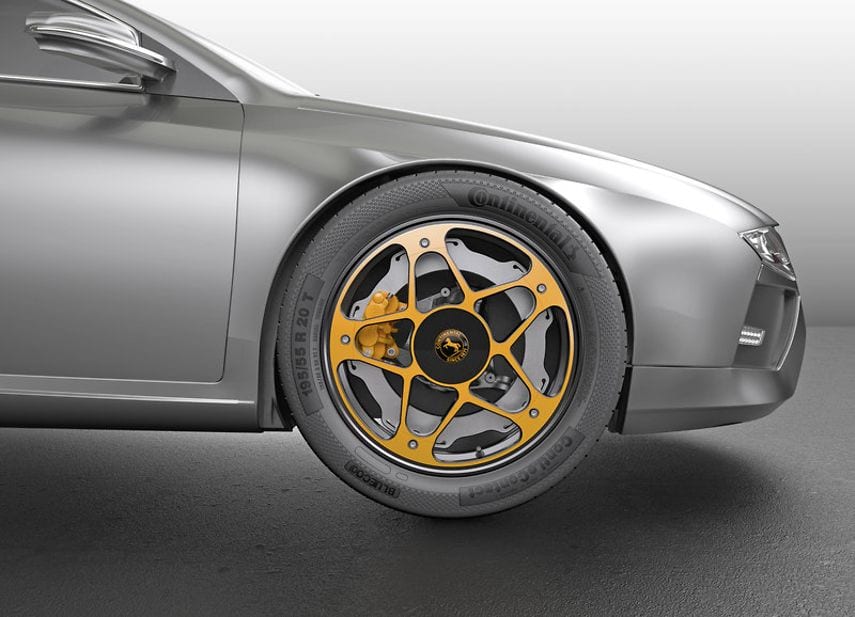
German Chancellor Angela Merkel this week reaffirmed her commitment to having 1 million EVs on the country’s road by 2020. In an interview with German YouTuber Lisa Sophie, Merkel reportedly said that the country has not abandoned its commitment to its one million EV goal by 2020 but that not enough was done up to now, signaling a possible ramp-up of the country’s efforts in the next two years. Merkel did not accept all of the blame for the slow pace but laid some of the responsibility on automakers which she doubts were sufficiently innovative enough to progress the technology.
Merkel will meet with local government officials on the 4th of Septemeber to discuss emission targets and indicated that around $600 million would be made available to improve urban transport infrastructure.
Although EV sales in Germany skyrocketed this year, the country so far only has just over 100,000 EVs registered. German EV sales data released this week showed that at the end of July nearly as much EVs have been sold as for the whole of 2016. EV sales in Germany are expected to continue its strong performance, supported by initiatives such as that of Nissan which announced that it would offer a scrapping bonus of EUR2000 ($2,348) for buyers converting from ICE vehicles to its Nissan Leaf or a Nissan e-NV200.
In related news, Chinese EV sales data showed a 30% rise in EV sales for the year to date over the corresponding period in 2016. It’s wattEV2buy’s forecast that China will reach its target of 2 million registered EVs by 2020, and even exceed it as more models become available in the next two years. China is already standing more than 800,000 units of which 200,000 has been registered this year alone. It is our belief that the Chinese EV market is set to reach its one million EV milestone by the end of the year, in light of historically stronger second half sales.

The Indian power producer, JSW Energy, a thermal power producer with nearly 5,000 MW of capacity is set to shift its business to align itself with more sustainable energy offering. Although this strategy is adopted by most power producers JSW Energy’s shift is more radical, as it includes investing around $550 million in new businesses including the manufacturing of an electric vehicle by 2020. In an interview with the Hindu BusinessLine, JSW Energy’s CEO admitted that the company is venturing into a new competitive space but that it bets on the growth in the vehicle sector in India due to the expected disruption by EVs. The company is set to work with technical partners and have a 60% local content goal.
As the rush to EVs starts to accelerate auto part companies are investing more and more in the development of new technologies, helping to advance electric vehicles. The Korean auto part company, Hyundai Mobis, this week announced that its the first South Korean company to develop a bi-directional on-board charger (OBC) for vehicle-to-grid (V2G) applications. Industry commentators have been quick to claim EVs V2G capability as a key attribute of the technology, but to date, no production vehicle comes equipped with the application as a standard feature. A contributing factor for the slow adoption of V2G technology is the slow development of software to optimise the charging / depleting of batteries so that drivers are not left stranded due to supplying the grid with power.
Other technology advancements unveiled this week include the German auto parts company, Continental, introducing a new lightweight wheel and braking concept for EVs. In a press release by the company highlighted the technology as follows:
As the push for cleaner cities drives the EV revolution forward, we are seeing more and more electric delivery vans entering the marketplace. Gone are the days of an EV delivery van being associated with the defunct Azure Connect or the small Renault Twizy Cargo which hardly had enough space or range to cover the average daily distance for delivery vehicles of 65 miles. The past month has seen the introduction of production versions of the Daimler Fuso E-Cell and the new Renault Kangoo ZE. This week two more delivery vehicles made the front pages. Ford and Deutsche Post subsidiary, Street Scooter, this week introduced its first jointly produced E-Van, the StreetScooter Work XL in Cologne. The Work XL is based on the Ford Transit Van and has a load capacity of 20 cubic meters, a modular battery system that could be sized from 30kWh to 90kWh for a range of between 80km and 200km. The 22kW onboard charger allows for an average charging time of three hours. Each WORK XL could save around five tonnes of CO2 and 1,900 liters of diesel fuel each year. StreetScooter will assemble around 150 units by the end of 2017 at its Aachen plant and ramp up to 2,500 units by the end of 2018. The Deutsche Post DHL Group is the largest operator of electric vehicles in Germany with a fleet of 3,000 StreetScooter Work and Work L vans and 10,500 pedelecs.
In the US, Chinese owned and Californian based EV start-up, Chanje, announced that it would introduce its first medium size fully electric delivery vehicle, the V8070 by the end of the year. The V8070, below on the right, has a 100-mile range with a 6,000lbs payload and 7.2kW onboard charger. Chanje has raised funding of $1 billion from various partners including Hong Kong-based FDG Electric Vehicles Limited which manufacturers the Yangtze EV in China.
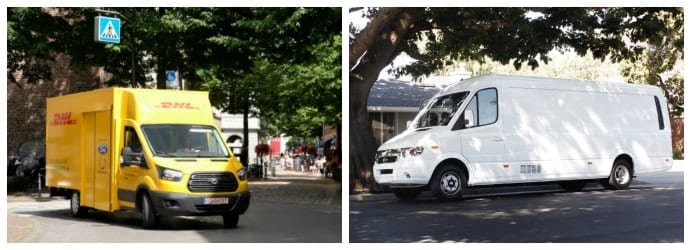
As the race for electric vehicles hots up so it does for autonomous vehicles as car makers try and regain the edge it lost in the EV sector to tech start-ups. Fiat Chrysler Automobiles (FCA), dead-last in the EV race, this week joined the BMW Intel self-driving car alliance as the company gears-up to produce self-driving cars by 2021. The BMW led alliance also includes Intel’s recently acquired Israeli tech company, Mobileye, Delphi Automotive, and Continental. Together the alliance will have 140 self-driving test vehicles on the roads by the end of 2017. Interestingly enough FCA is also a partner with Google’s Waymo where it developed and deployed autonomous Chrysler Pacifica minivans.
The Michigan Economic Development Corp funded American Center for Mobility announced that it will start operating its autonomous vehicle testing ground in December 2017. The converted Willow Run facility, first used for airplane testing, is a two-and a half-mile highway test loop. Michigan, which has been one of the pro-active states in self-driving development invested around $110 million in the conversion and expects to develop a second facility by 2019 to represent urban driving conditions.
US Chipmaker, NVIDIA, which led the push into autonomous technologies ahead of its competitor Intel, this week announced its investment in two-year old Chinese self-driving truck start-up TuSimple. The undisclosed investment by NVIDIA was part of $20 million funding round led by Sina, the Chinese Social Media company. TuSimple recently completed a Level 4 autonomous trip from San Diego to Yuma, Arizona.
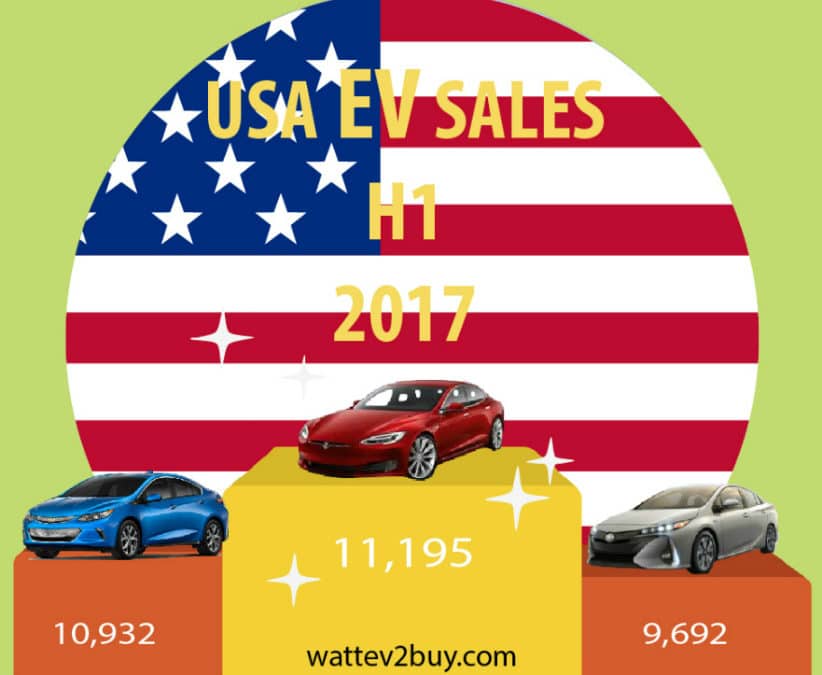
We look at the Top brands, Best and Worst Models and how the battle between battery electric (BEV) and plug-in hybrid (PHEV) technologies play out in the summary of USA EV Sales H1 2017.
The highlights for USA electric car sales in H1 2017 was:
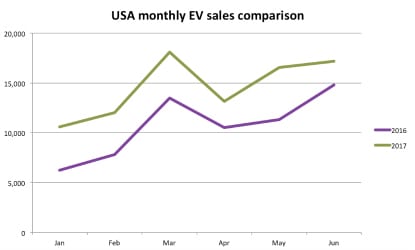
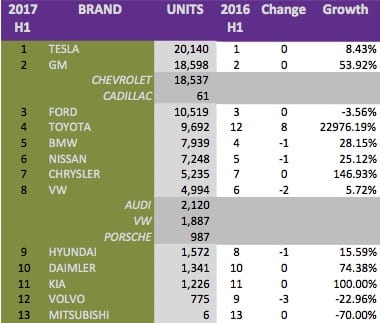
There are no surprises in the Top 3 EV brands with Tesla holding on to its lead over GM due to a 24% rise in Tesla Model X sales. GM could not dethrone Tesla even with a new model, the mass-market Chevrolet Bolt EV up its sleeve. Improved sales in the 2nd Quarter from the Ford Fusion Energi and C-Max Energi helped the brand retain its third position fighting off the strong performance of Toyota with the new Toyota Prius which was placed third at the end of the first quarter.
Most brands showed improved sales growth over the first half of the year with only Ford, Volvo, and Mitsubishi showing declining sales. The Volkswagen Group showed a declining trend as the year progressed and mustered the lowest growth. The declining fortunes of the German automaker can be attributed to the Volkswagen e-Golf not being able to compete on range with the new mass-market Chevrolet Bolt being sold in the same price bracket. Chrysler showed the highest growth after Toyota buoyed by the new Chrysler Pacifica and great specials on its compliance car, the Fiat 500e. The results might have been better for the US automaker, but the Chrysler Pacifica launch was delayed and then impacted by recalls and plant closure due to battery problems.
Most of the existing models showed growth lower than the overall growth due to the big number of new models to the market. Surprisingly the Ford Focus and Fiat pure electric models outperformed the market showing that the public is becoming more comfortable with range issues and the continuously improving charging infrastructure is starting to have and effect on top of the financial incentives making EVs appealing.
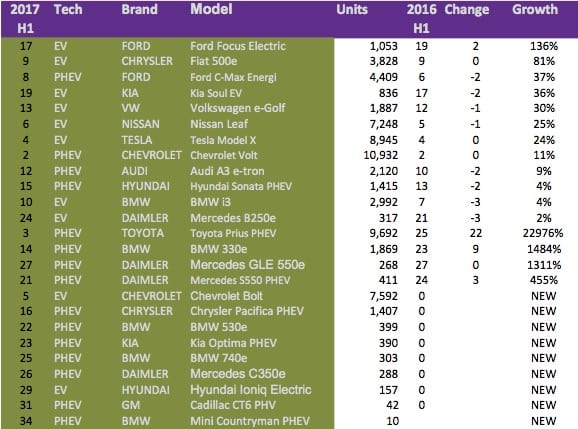
European plug-in vehicles were the biggest losers in this half of 2017 with a number of the luxury PHEV models losing big. Volvo and BMW saw some of their relatively new models losing steam. Both the BMW x5 xDrive and Volvo XC90 T8, released in 2016, lost market share in favor of the Tesla Model X. The Tesla Model S sales have flatlined although it remained the top selling BEV model. It will be interesting to see how the new Daimler Smart ForTwo ED fares in the second half of 2017. The German automaker is relaunching the brand as electric only in the USA and Canada from this summer and will offer a slightly improved model at a marginally reduced $23,800 starting price before incentives.
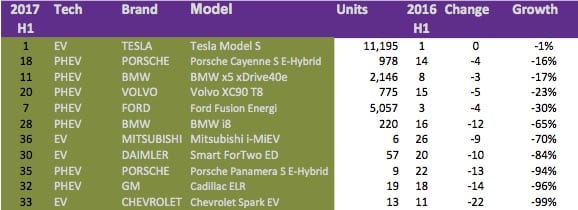
Battery electric vehicles are still maintaining its lead over plug-in hybrids albeit at a lower margin. BEVs took six positions in the Top 10 EV sales for the USA in the first half of 2017. The ever increasing number of plug-in models benefits the technology in the short term as it competes with only a handful of pure electric models. The Plug-in hybrid category benefited mostly from the release of the new Toyota Prius and to a lesser extend the Chrysler Pacifica. The Tesla Models X and S constitute nearly 44% of all BEV models showing the company’s dominance in the sector. The commanding position will improve even more with the release of the Model 3 in the second half of 2017 which might add about 40,000 units depending on the production ramp-up. The release of the Tesla Model 3 and new Nissan Leaf, expected by the end of the year, should help pure electric vehicles outperform the more dirty plug-in hybrids in the second half.
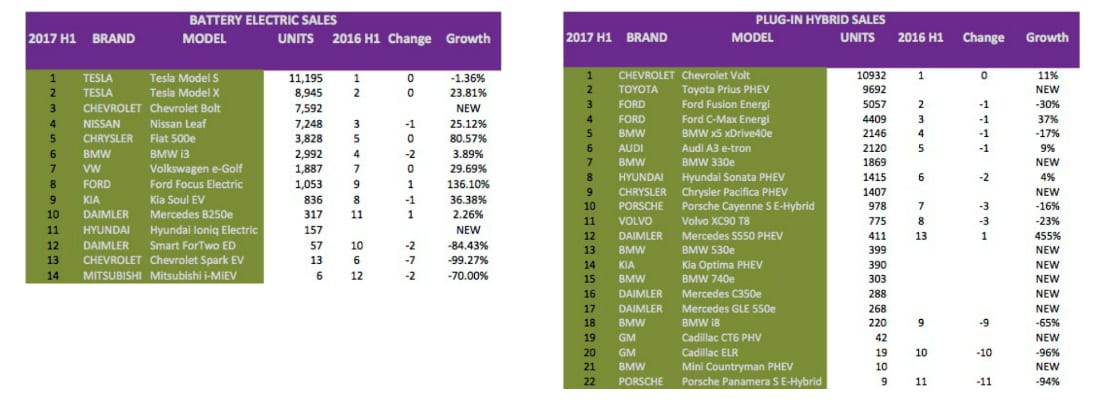
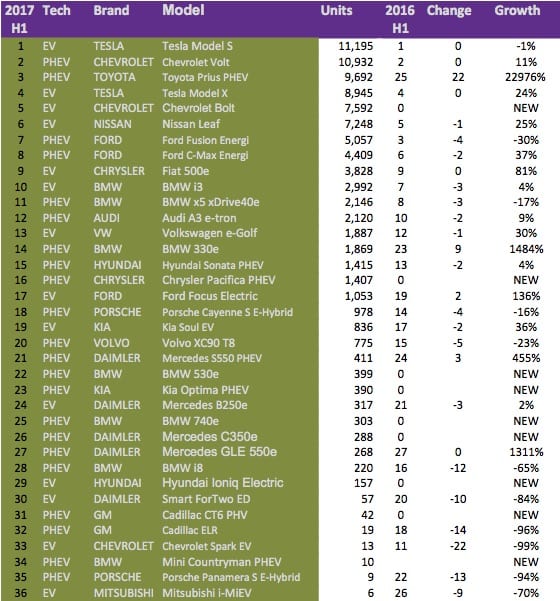
Be sure to check out our new presentation of all EVs since 2010 to gain great insights on all auto brands and their electric vehicle strategies. We have also created presentations per technology type BEV, PHEV, and FCEV.
The page you requested could not be found. Try refining your search, or use the navigation above to locate the post.

EV sales in the USA are up 43% Year-to-Date after sales in May resulted in it being the second best month for electric cars for the year 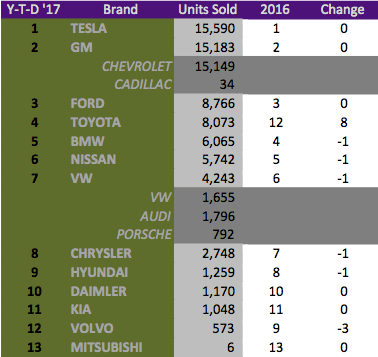 so far. May 2017 sales outperformed May 2016 with a 46% increase. The tussle between BEVs and PHEVs is to close to call as pure electric vehicles continue giving ground on the lead at had over PHEVs, with PHEVs outselling BEVs in May with 8,325 units vs. 8,243 pure electric vehicles which include the BMW i3 REx.
so far. May 2017 sales outperformed May 2016 with a 46% increase. The tussle between BEVs and PHEVs is to close to call as pure electric vehicles continue giving ground on the lead at had over PHEVs, with PHEVs outselling BEVs in May with 8,325 units vs. 8,243 pure electric vehicles which include the BMW i3 REx.
The best performing electric vehicle for the month was the Toyota Prius, dethroning the Chevrolet Bolt for the first time this year. The Tesla Model S also dropped out of the top 3, a rare occurrence, making way for its sibling, the Tesla Model X. The Hyundai Ionic and Chrysler Pacifica both climbed five or more positions for the year, with the Chevrolet Bolt increased its units sold with 21% on April but remaining in the 5th place overall for the year. The big losers for May 2017 were the Mercedes C350e, Audi A3 e-tron, and Ford Focus Electric.
The Top 3 brands remained the same as this time last year with Tesla, Chevrolet and Ford taking the top three positions. The rest of the brands had to make way for the rise of Toyota, taking the 4th place. Volvo gave up the most ground, falling from 9th to 12th spot.

Toyota confirmed this weekend that it divested from Tesla as it exited the co-operating agreement the companies had on electric vehicle technology. Toyota acquired 3.15% in Tesla in 2010 for $40.5 million, a stake which would have been worth $1.75 billion at Friday’s close. According to the Japan Times Toyota announced that the sale of the stake, which happened in trances between October 2014 and the end of 2016, is “a part of a regular review of business alliances.” The partnership resulted in the development of an electric Toyota RAV 4, which was abandoned as the company changed course away from EVs to hydrogen fuel cell technologies.
The Indian Government’s Department of Energy posted a blog in which it reiterates its ambition to only sell EVs by 2030 through its National Electric Mobility Mission Plan on which we reported on in Week 17. The Government’s plan set a target of between 6 and 7 million units by 2020 already, which seems overly ambitious as EV sales have yet to pick-up in the country. One if its largest automakers Mahindra and Mahindra last week announced that it only now plans to increase its battery production capacity from 500 units to 5,000 a month, a far cry from what should be needed if it wants to produce its fair share of 6 million units. The blog sees that EVs will reach parity with ICE vehicles by 2022. Bloomberg New Energy Finance in a report last week saw this only happening in 2025. Automakers such as Mahindra is reluctant to overly invest in EV manufacturing infrastructure while the prices of ICE cars remain cheaper than EVs in a country where the consumer is very price sensitive. The Indian Government is yet to definitively announce what financial contribution it will make towards achieving the goals, other than saying it acknowledges that it will need to carry the industry for the first three years.
Chinese Premier, Li Keqiang, and German Chancellor, Angela Merkel met on Thursday to discuss various trade issues between the two countries, amongst others the impact of the China’s ZEV-like quota on German automaker’s expansion plans in the Asian country. The Chinese Government proposed that car manufacturer had to achieve a level of 8% EV sales by 2018. Although not confirmed Reuters on Friday reported that the Chinese Government agreed to delay the quota to 2019 for German companies but that they should ramp up EV deliveries at a later date.
As the electric vehicle sales in neighboring Norway climbed 30% year-on-year for the month of May the CEO of Russia’s largest oil company, Rosneft PJSC, Igor Sechin denounced EVs as overrated. Mr. Sechin was quoted by Bloomberg during a speech at the St.Petersburg International Economic Forum saying Tesla is overvalued and EVs are “not as popular as had been expected” in Europe’s biggest economies. Mr. Sechin went further saying “The market’s assessment of the prospects of electric car producers, in our view, is significantly overestimated,” and that “Until the electric transport industry becomes as user-friendly and attractive for consumers as the cars with internal combustion engines, the prospects for electric vehicles remain largely uncertain.” Rosneft that had 2015 revenues of nearly $100 billion market value was clipped by that of Tesla at the end of May 2017. Tesla shares were up nearly 60% for the year while Rosneft was down 20%.
We acknowledge Donald Trump leaving the Paris Climate Pact but took a decision to rather report on other EV related stories of the week.
Interested in learning more about Chinese electric vehicles? Download our fun and easy app below, flick the China switch and swipe left the models you don’t like, right the ones you do, enter the chat rooms and share your thoughts with the community.
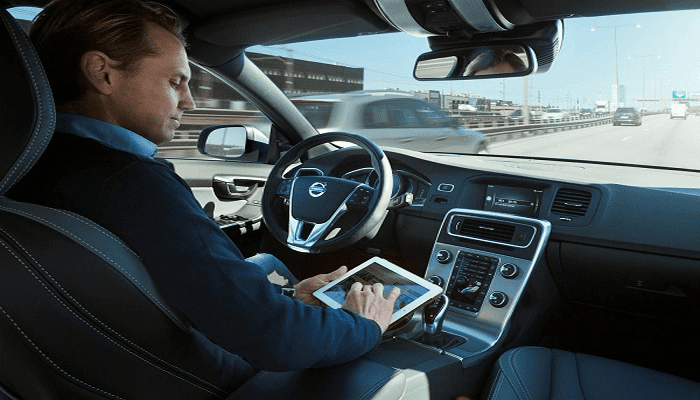
A slew of self-driving pilot programs has been announced recently, the latest being Delphi. The auto parts company previously owned by GM announced that it would roll out self-driving taxis in the USA this year. Delphi is already piloting a program in Singapore where it pilots an Audi SQ5, kitted with 26 sensors. The pilot would be extended to three vehicles in June and is done in conjunction with the Singapore government where the company hopes to have operating taxi service within three years. According to Automotive News it is anticipated that Delphi will host the US pilot in either Pittsburg or Boston and that services would commence in September 2017.
Delphi’s pilot program allows passengers to see what the cars “brain” sees on a tablet, which it calls its “comfort cam”, soothing first-time users of the service. Already speculation is rife that Intel, which just last month paid a staggering $15 billion for Isreali autonomous tech company, Mobileye, would acquire Delphi. The three companies are already integrating their technologies to provide autonomous systems for car manufacturers, as soon as 2019.
Delphi would extend the pilot to Europe in the 3rd quarter and will switch its test vehicles to an undefined electric vehicle by 2018. The regulatory environment for public testing eased last week as Germany passed a law allowing for the public testing of autonomous vehicles.
Competitors, Lyft and Waymo also signed a partnership agreement this week. Waymo, previously know as Google’s self-driving program is already piloting Chrysler Minivans and Lexuses in Phoenix. The company last month invited people living in South East Phoenix to apply for the program, allowing the participant to hail a ride via a mobile app for local trips. Already as much as 10,000 such rides have been completed by Google staff. Waymo announced in April that it would increase its autonomous fleet from 100 to 600 Chrysler Pacifica minivans. It is no surprise that Waymo did not partner with Uber since Waymo claims that Uber stole some of its technology in an ongoing court case between the two companies. Reuters reported that according to Lyft the transaction is not exclusive, leaving the door open for other partnerships such as Lyft’s shareholder GM.
GM paid $500 million last year for a stake in the USAs number two ride-sharing company; the automaker also acquired Cruise Automation to spearhead its autonomous vehicle strategy. GM is very aggressive in the autonomous space, trying to carve out a lead to make up for ground lost to newcomers such as Tesla. GM is spending vast amounts of money to this end, for instance paying $1.1 billion to acquire its second Y Incubator company, the Italian based OSVehicle, to develop a self-driving “Vehicle-as-a -Service” (VaaS) platform. GM’s efforts are seeming to pay off as the respected research firm, Navigant, recently ranked it and Ford at the top of the self-driving leaderboard.
Companies like Delphi, Intel, and Nvidia, are hoping to sell their driverless systems to automakers in what is expected to be a market of around $100 billion within the next couple of years. BMW last week unveiled 40 BMW 7-series equipped with Intel’s driverless technology. The test, using the specially converted autonomous 7-Series is part of the German company’s project that will see 155 million test miles driven. Nvidia, an early front-runner in the self-driving tech space lat week, announced that Toyota would use its autonomous microchip built on Nvidia’s artificial intelligence platform called Drive PX. Both Daimler and Audi have already partnered with Nvidia on its Drive PX system.
Precursors to larger ride sharing and hailing services would be regulation, computing infrastructure, and connectivity. Governments would have to enact regulation to allow driverless cars while processing power and data centers need to be increased many fold to accommodate driverless technology. So also is 5G connection a requirement, daily use of an average self-driving car would be four terabytes of data.
In February we provided a summary of the disengagement reports by companies doing public testing on Californias’ roads. Only 10 of the permitted 20 companies filed reports, this number would definitely increase in 2017 judging from all the pilots announced recently. The pilot programs currently in action are mostly for level three and four autonomy and are expected to be commercially available from 2020 onwards. Even though it is expected that the Tesla 2018 models would have level five compliant hardware installed full autonomy is only expected in the latter half of the next decade.
The video by BMW below provides a short overview of the different autonomous driving levels.
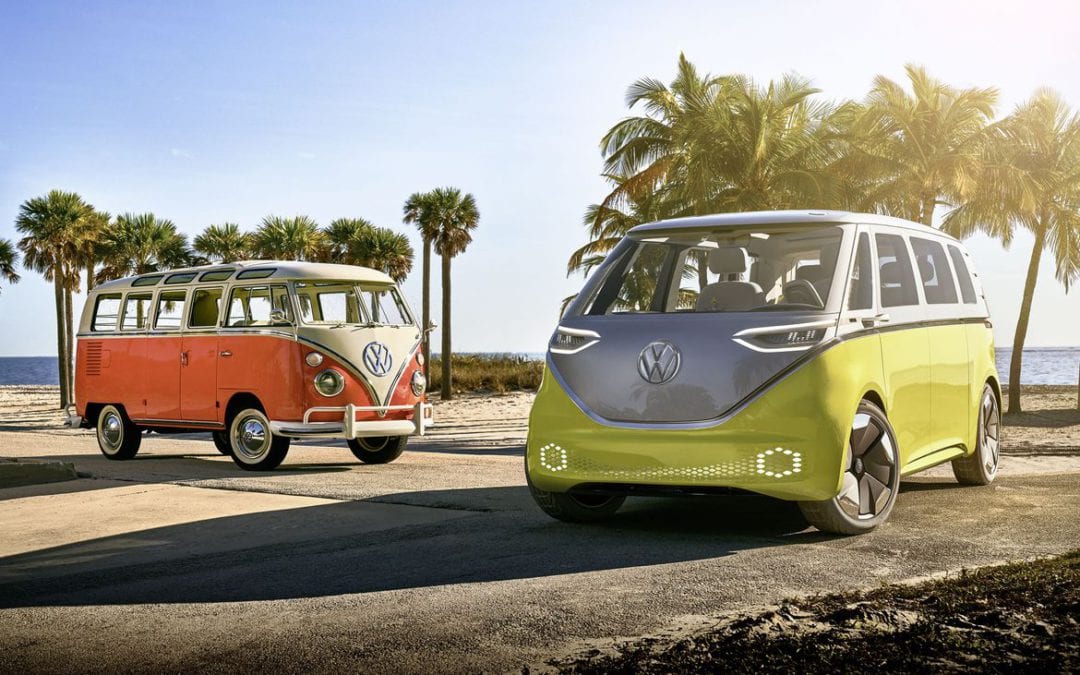
#1 – VW Strategy – The future is electric, long live the combustion engine
The VW shareholders this week approved the automaker’s electric vehicle strategy, “TOGETHER – Strategy 2025” and accompanying budget at the AGM held in Hamburg. Unpacking the VW CEO, Matthias Müller’s, statements the VW strategy is – “The future is electric, long live the combustion engine.
The VW board recently upped its €3bn investment in alternative drive engines from the previous five years to €9bn by 2022. The company, however, will spend €10bn on cleaner combustion engines over the same period. VW sees conventional engines to be between 10% and 15% cleaner and efficient by 2020.
Mr. Muller was quoted as saying “We intend to be the No. 1 in e-mobility by 2025”. He went further elaborating how the company will achieve its strategy. “This is how the Group will be rolling out more than 10 new electrified models by the end of 2018. By 2025, we will be adding over 30 more BEVs.” The newly-established Center of Excellence in Salzgitter will bundle Group-wide competence in battery cells and modules. “At the same time, we are conducting intensive negotiations to establish partnerships in the field of battery cells in Europe and China. You will soon be hearing more about this”, the CEO added.
According to Müller, modern internal combustion engines will nevertheless be indispensable for the foreseeable future: “This applies also and especially to the Euro 6 diesel, despite the current heated debate.” In total, the Volkswagen Group will be investing around 10 billion euros in these technologies by 2022, Müller: “The internal combustion engine primarily is part of the solution, not part of the problem.”
The German automaker decided to use partnerships as a tactic in achieving its goal. Müller referred to several examples such as the plans to enter the economy segment with Tata, the envisaged joint venture with JAC in China to develop attractively-priced electric cars, and numerous cooperation projects in the field of mobility services.
The e-mobility sector is going to become very crowded for VW as most automakers have already embarked on the same strategy. See the reference to Ford later in this week’s newsletter. Daimler has already accelerated its strategy and brought forward its $11Bln investment from 2025 to 2022 this year. read our blog of this week where we compare the Daimler and BMW strategy.
#2 – Electric MotoGP from 2019
MotoGP enthusiast with a preference for electric bikes can finally look forward to their own Formula E-type event. The MotoGP franchise this week made it official that a support class, consisting of five races would be held from 2019 onwards. The races would initially only be held in Europe, with four manufacturers supplying 18 bikes on the grid. Similar to the Formula E the racing bikes would all be the same and is expected to reach speeds of 124mph (200km/h), which is slightly slower than their combustion counterparts.
While on the topic, the Formula E, which is now in its third season will host a race in Monaco this weekend. The franchise will also host an event in Paris next week.
#3 – GAC breaks ground on $6.5 bln electric industrial park
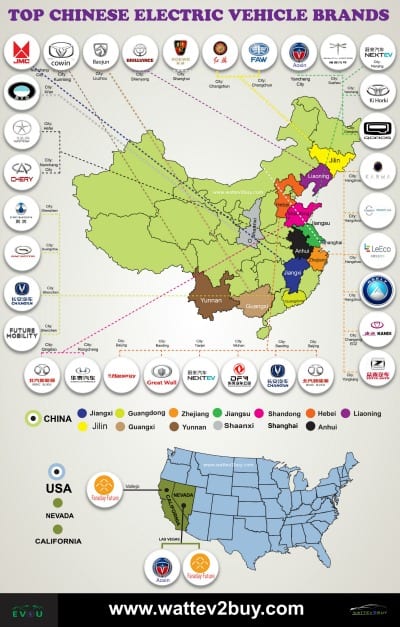 China’s Guangzhou Automobile Group (GAC), a Top 10 Chinese automaker and voted as the “2016 BEST CHINESE CAR BRAND” in the official customer satisfaction survey broke ground on its $700 million 200,000 EV plant. The plant which forms part of a larger $6.5 industrial park which focussed on purely on the EV sector. GAC has international ambitions for its electric vehicles and this year introduced the GE3 BEV at the North American International Auto Show. The GE3 follows on the GAC GS4 concept EV introduced in 2015 at the Guangzhou A
China’s Guangzhou Automobile Group (GAC), a Top 10 Chinese automaker and voted as the “2016 BEST CHINESE CAR BRAND” in the official customer satisfaction survey broke ground on its $700 million 200,000 EV plant. The plant which forms part of a larger $6.5 industrial park which focussed on purely on the EV sector. GAC has international ambitions for its electric vehicles and this year introduced the GE3 BEV at the North American International Auto Show. The GE3 follows on the GAC GS4 concept EV introduced in 2015 at the Guangzhou A uto Show. The GE3 is expected to be market ready by 2018. The company launched its GA3S PHEV in July 2016. The GA5 PHEV, based on the Alfa Romeo 166 came to market in 2015 and had sold around 5,000 units by the end of 2016. The GAC Trumpchi GS4 SUV EV is available since mid-2016.
uto Show. The GE3 is expected to be market ready by 2018. The company launched its GA3S PHEV in July 2016. The GA5 PHEV, based on the Alfa Romeo 166 came to market in 2015 and had sold around 5,000 units by the end of 2016. The GAC Trumpchi GS4 SUV EV is available since mid-2016.
Guangzhou is a city in Guangdong Province, which also includes the city of Shenzhen where EV manufacturer Denza, Changan, and Future Mobility are present. Click on our interactive map to click through to the various Chinese EV manufacturers.
#4 – Bollinger teases electric pickup
While most auto companies are trying to play catch up with Tesla, pinning their hopes on producing a luxury electric SUV. While the auto companies race to capitalize on the popular vehicle class to carve out a lead in the sector, a huge gap is open in the form of electric SUTs (Sports Utility Trucks). Now history is repeating itself with start-ups rushing to fill the gap. This week Bollinger Motors, started in 2014 in Hobart NY State USA teased the Bollinger SUT. The tease in the form of a picture of the interior cabin follows on a rendering earlier this year of the outside reflection of the pickup. The company is taking $1,000 refundable deposits to secure a SUT that could be configured to your use requirements. Bollinger plans to unveil the vehicle by July 2017. The powertrain is said to be revolutionary. Last week Workhorse unveiled its W15 concept range extended electric pickup truck. The Workhorse W-15, by the Ohio-based company with the same name, is set to sell for $52,000 and have a 60kWh (40kWh nominal rated) battery pack, promising a range of 320 miles.
#5 – Think Tank predicts 95% of miles will be shared and autonomous by 2030.
CNBC ran an article on the prediction by the US thinktank RethinkX that 95% of miles traveled will be in electric powered autonomous cars by 2030. The controversial prediction is way above that of Boston Consulting which predicted that only 25% of such trips would be in self-driving or shared vehicles. Looking at the website of Tony Seba, a co-author of the RethinkX study, “Rethinking Transportation 2020-2030: The Disruption of Transportation and the Collapse of the ICE Vehicle and Oil Industries.” the report also predicts that only 20% of Americans will own cars by 2030.
The predicted shift in mobility leads into other news this week where Ford’s CEO was challenged on his strategy for the company, resulting in its performance lagging its competitors. Mark Fields, CEO since 2014, embarked on what is the auto sector icon’s biggest strategy shift in history by investing heavily in self-driving technology. The challenge for the Ford CEO’s strategy is that he has one foot in the future and one in the present, resulting in an earnings decline of 42%.
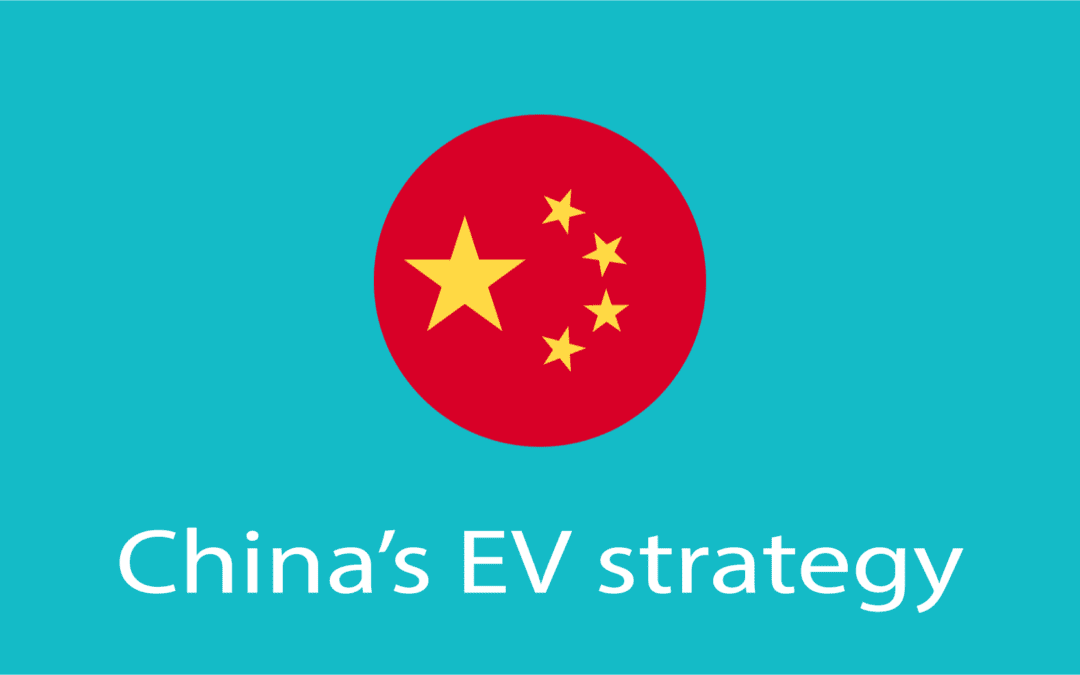
The Chinese Government released its long-term development plan for the automotive sector on the 25th of April 2017, setting out the China EV strategy. The plan, presented by the Ministries of Science and Technology and Ministry of Industry and Information Technology in conjunction with National Development and Reform Commission, sets out how the country will ramp up the local EV sector and dominate the world market.
If successful the Chinese auto sector can leapfrog the dominance of the big auto companies, such as Toyota, VW, BMW, Daimler, Ford, and GM. Big Auto has missed the boat on electric vehicles and therefore continue to downplay the technology as only a niche sector. Management boards of big auto companies are flip-flopping strategy as they try and come to grips with how to enter the market and to what extent they should invest in research in technology. BMW last week announced that EVs constituted 3% of its total sales for the first quarter of 2017 after a jump in EV sales of 50% (Top 5 EV News Week 18). With the release of the data, the company set out how it will introduce more models. The news from BMW is in stark contrast from news only six months earlier when the Board grappled with if it should pursue EVs at all (Top 5 EV News Week 49  2016). In the USA we have recently seen how newcomer Tesla is valued above Ford and GM by investors. The response by Big Auto and other detractors of EVs was that this is a temporary phenomenon, arguing that Tesla hardly produces one tenth of the vehicles any of the top brands does. If one look at total sales of Battery Electric Vehicles (BEVs), it seems investors on the other hand value companies on their future ability to produce electric vehicles. If the same apply for Chinese brands, we can very quickly expect a Chinese brand to ascend the list of top auto brands.
2016). In the USA we have recently seen how newcomer Tesla is valued above Ford and GM by investors. The response by Big Auto and other detractors of EVs was that this is a temporary phenomenon, arguing that Tesla hardly produces one tenth of the vehicles any of the top brands does. If one look at total sales of Battery Electric Vehicles (BEVs), it seems investors on the other hand value companies on their future ability to produce electric vehicles. If the same apply for Chinese brands, we can very quickly expect a Chinese brand to ascend the list of top auto brands.
According to the plan by the Chinese Government, it set a short-term target of EV sales of 2 million units locally by 2020 and at the same time elevate Chinese auto brands to be seen amongst the top ten electric vehicle brands globally. The medium term target is that EVs contribute 20% of the total annual fleet by 2025, which is a huge amount of cars. Measuring the movement in sales by brand in the table below we can already see the top Chinese EV brands, BAIC, SAIC, Geely Zhidou and JMC moving higher and two brands, BAIC and BYD in the top ten list for the first quarter 2017. Other evidence of Chinese companies investing heavily in the sector includes Chinese IT company, Tencent acquiring a significant stake in Tesla, sparking a rally in the stock.

Measures by the Chinese Government to achieve the targets above include:
China already has experience of setting itself to dominate a sector and achieving set goals. Less than a decade ago the Chinese Government plotted to dominate the PV panel market and in the process brought down the price of energy production from renewables, killing some western PV manufacturers in coal plants in the process. Already we are seeing a deluge of battery cell plants being planned by the end of the decade in China. We can, therefore, expect the same domino effect as in the energy markets, taking out auto manufacturers that were slow to embrace electric vehicles.
Interested in learning more about Chinese electric vehicles? Download our fun and easy app below, flick the China switch and swipe left the models you don’t like, right the ones you do, enter the chat rooms and share your thoughts with the community.

#1 – USA April EV Sales continue upward trend
USA EV sales for April were released this week showed an increase of nearly 25% on a year-on-year basis, bringing the 2017 figure to 54,000 units for the year-to-date, which is 41% ahead of the 38,000 for the same period in 2016.
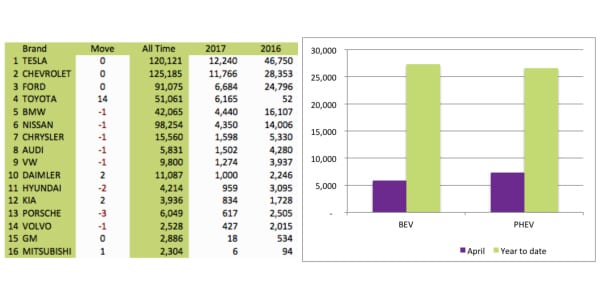
PHEV vehicles are gaining on the lead of BEV vehicles as Toyota Prius sales continued its upward momentum while deliveries for the Nissan Leaf and Tesla’s Models S and X slipped (hard). Sales for new models introduced through the month were a mixed bag, with the Cadillac CT6 PHV only racking up 6 units while the Chrysler Pacifica PHEV mustered 205 units after a delayed start to the year. The Chevrolet Bolt recovered nicely and Fiat had a record month with the 500e after introducing special deals. A big loser was the Mercedes C350e, dropping to only three units from a high of 210 in January.

#2 – Citroën’s EV strategy unwrapped
Citroën this week shed some light on its electric vehicle strategy. The PSA Group company plans EVs across the range starting 2020. The strategy mimics Hyundai’s strategy with the Ioniq, having an ICE, PHEV and BEV version. The approach is seen as quite expensive, but hopefully, the company gained some inside knowledge from the Citroen C-Zero, one of the first EVs of the decade.
Citroen CEO Linda Jackson was quoted by Automotive News Europe as follows – “Our strategy for electric vehicles is not to have a vehicle dedicated to electric, but to have electric across the range so that customers can choose a gasoline model or an electric model.”
Another PSA group company, DS Automobiles the luxury marque for the French automaker, this week announced that it would have an EV by 2019.
#3 – Tesla’s shares retreats after hitting our target
Tesla shares early in the week hit the target of $320 we predicted on the 3rd of April after which it came back to test the breakout when the company announced a loss of $322m for the quarter despite more than doubling revenues. Interestingly enough if you list GM, Tesla and Ford’s market cap and total units sold it seems that investors are valuing the three top brands in the USA on their EV unit sales only.
We picked up in the fine print of the release that Tesla will add a 100 retail, delivery and service locations during 2017 globally, representing a 30% increase. The company will also add 100 Tesla Ranger mobile repair trucks during the second quarter. The production of 5,000 Model 3s per week is still on track to commence in July.
#4 – California taxes ZEV owners
The California legislature this week passed a bill to increase revenues from the transport sector in a bid to cover the increased cost of maintaining road infrastructure. The Bill included an annual levy of $100 on ZEV vehicles to compensate for the fact that EV taxes can’t be recovered at the pump. Diesel and gasoline prices increased by $0.36 and $0.30 per gallon. California is home to nearly half of all EVs in the USA.
In other regulatory news this week impacting on EV growth the EU approved a joint venture between BMW, Ford, Daimler, and VW to develop a fast charging network in across the union. The companies will hold equal shares in the JV.
#5 – EVs now 3% of BMWs sales
BMW this week released its sales data for the first quarter 2017, showing that EVs now constitute 3% of its total sales as EV sales jumped 50%. The Chairman of the Board, Mr. Harald Kruger was quoted saying “We are therefore well on course to delivering more than 100,000 electrified vehicles for the first time in 2017”. The company also announced that it would start producing it iNext autonomous brand at its Dingolfing plant form 2021. Other models expected from the German automaker is the i8 Roadster PHEV (2018), a BEV Mini (2019), and a BEV X3 (2020). The news from BMW is in stark contrast from news only six months earlier when the Board grappled with if it should pursue EVs at all (Top 5 EV News Week 49 2016).
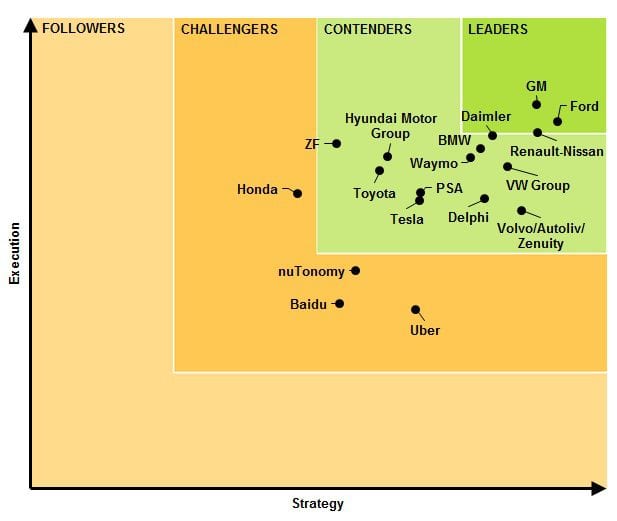
Navigant Research placed Ford and GM at the top of its autonomous driving leaderboard, surprisingly far above Waymo (7th), the pioneer of autonomous driving. Waymo was only listed as a contender, and Tesla who has already clocked over 300 million miles in Autopilot (Level 2 Autonomy) did not make the Top 10 list. Waymo, not aiming to develop a car, but rather focusing on autonomous technology has partnered with Chrysler and Ford on testing autonomous technology.Making Navigant’s findings even more surprising to us is that
Making Navigant’s findings even more surprising to us is that Waymo performed exceptionally well compared to other automakers on the list when comparing across all permit holders allowed to test autonomous tech on Californias public roads. According to CA DMV regulations, each permit holder must annually file a disengagement report, reflecting the number of events where a driver essentially has to take over from the vehicle’s autonomous mode to either prevent a traffic incident or where the system fails. Waymo posted a record 0.2 disengagements per 1,000 miles in its 2016. For a breakdown of each permit holders testing in California read our recent blog providing detailed analysis. The table below shows a summary of all the permit holders in the CA DMV program’s disengagements per 1,000 miles.

Despite Tesla aiming to have a market ready Level 5 autonomous product by the end of the year, it is only listed as a contender. Tesla is criticized by some, for being too aggressive, using its customers as guinea pigs for its AutoPilot software.
Not surprising though is that Uber features on the bottom end of the list, the controversial ride-hailing company has been in the news lately for losing its right to test in San Francisco, being sued by Waymo and a crash in Tempe, Arizona, temporarily halting its pilot program.
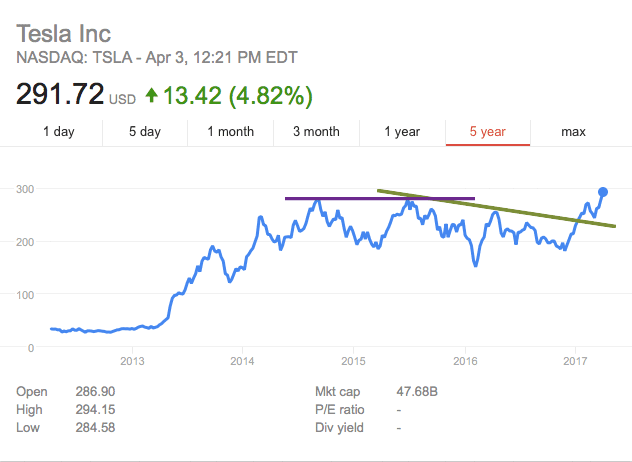
Tesla (NASDAQ: TSLA) shares broke through its $280 resistance level on record sales for the first quarter 2017, leading investors to re-evaluate their outlook for the company. The results showed that Tesla could deliver above market expectations. The sentiment is supported by a decrease of vehicles in shipment, of around 1,800 units. Investors are now reconsidering the poor market guidance for the company to deliver on its Tesla Model 3 promises. The Q1 sales of 25,418 units show a growth of 12% on the previous quarter, which is a massive 69% on year-on-year basis. The Tesla Model X was the star, showing around 22% growth at 11,550 units, while the Model S sales grew by nearly 6%.
Today’s intraday share movement makes Tesla’s market value more than Ford (NYSE: F) and sees it gaining on General Motors (NYSE: GM), officially making it the number two in the sector. The electric vehicle manufacturer, which some still sees as a start-up, intraday market capitalization stood at around $47.95 billion, while Ford’s value dropped to $44.91 billion, on the back of a share price that was down 5%, caused by a decrease in March sales of 7%. GM shares also suffered a sell-off of around 4% on a marginal growth of just over 1%, bringing the companies market cap well within reach of Tesla at $50.78 billion.
Both GM and Ford have missed the opportunity in electric vehicles. The automakers recently wrote to President Donald Trump, in an attack on EV’s, through the Alliance of Automobile Manufacturers, asking him to relax emission targets as they did not see consumer demand for electric vehicles justify such stringent EPA standards. Maybe investors are taking a cue from Hyundai’s shareholders, who revolted, resulting in the company changing its electric vehicle strategy in 2016.
The strong resistance of $280 which held since September 2014 saw the stock retreat after creating a double top formation at the level in July 2015. After testing the resistance for the second time, Tesla’s shares retreated to a low of $151 in Feb 2016. The first count on the breakout of the channel, which broke in January at $230, can see Tesla’s shares trade at around $320 in the near future. If all else remain equal, it will equate to a market cap of $52,2 billion, well above that of GM.
Share data, Google and Marketwatch
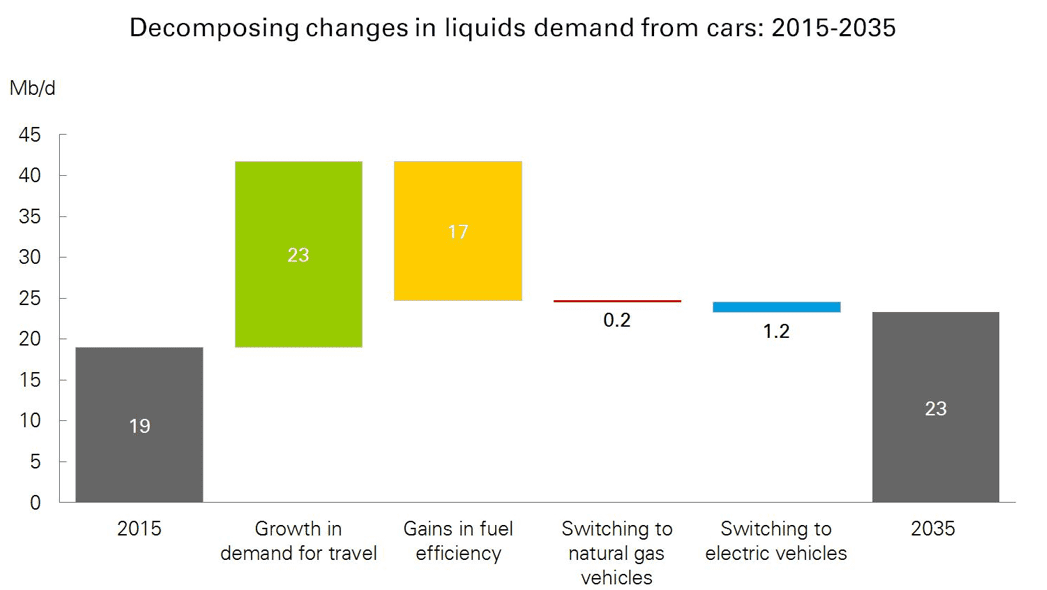
ONE
An article by OilPrice.com based on BP’s long-term energy outlook claims the electric vehicle car threat to the oil industry is overstated and a red herring for investors and other observers. The article cast doubt on if the achievability of a target of a 100 million electric vehicles by 2030, especially in a Trump era. Nonetheless, BP’s forecast still sees only a marginal effect of only 1.2 million barrels per day on oil demand if the target of around 7% EV’s by 2030 is reached. The article concludes that a bigger unknown to oil demand gains in fuel efficiencies, largely driven by more stringent emission targets.
TWO
Rumors about Apple’s secretive iCar named Project Titan has been circulating. MacWorld.co.uk speculated this week that Apple, the world’s most valuable company, has set itself a deadline of late 2017 to prove feasibility for a vehicle to rival Tesla.
THREE
Some policy gains were made this week in support for electric vehicles in the ongoing tussle targeting regulations for and against the technology. New York will from the 1st of April 2017 provide a $2,000 incentive to buyers of electric vehicles. In Wyoming, despite efforts by the Alliance of Automobile Manufacturers backed by Ford and GM to block Tesla from opening its direct sales business, the State Legislature this week approved a bill allowing Tesla to open its showrooms and sell vehicle’s without the use a middle man.
FOUR
Honda is setting itself up for failure with this week’s announcement that the much anticipated mid-sized 2018 Honda Clarity EV will only have an 80-mile range. Despite being a mid-size sedan, with the obvious space benefit it brings, the car will not even compete with smaller compact sedans and hatchbacks, such as the 2017 BMW i3 (114 miles), Nissan Leaf (107 miles) and the VW e-Golf (125 miles). The Honda Clarity EV’s direct competitors in the $30,000 to $35,000 price range, the Hyundai Ionic (124miles) and Tesla Model 3 (200 miles), will put it to shame.
FIVE
February Electric Vehicle sales data released for the USA this week reveals some interesting talking points. Overall, February sales gained a further 13.4% in January 2017 and over 55% on year on year basis. Contributors to the increase came from a nearly doubling in sales of the Tesla Model S and continued demand for the new Toyota Prius Plus. Unfortunately, the Prius in our books hardly counts as an electric vehicle due to its underwhelming continued reliance on its combustion engine. Disappointingly, sales for the Chevrolet Bolt declined over 18% from January, bringing total sales for the four months to 3,272 units, far short if one takes that at a claimed 30,000 units per annum the Bolt should have sold 10,000 units during the four months. In the car maker standings, GM retained its lead with 2,776 units over Tesla’s 2,550 units with Ford taking third place with 1,704 units.
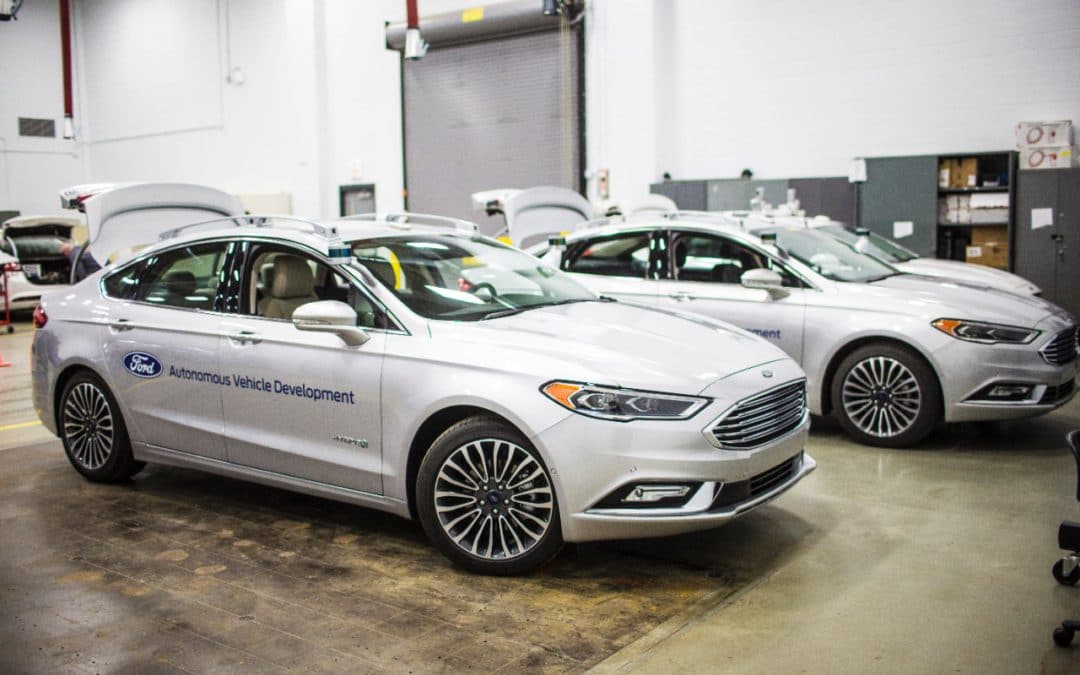
Ford debuted its next-generation Fusion Hybrid Autonomous development vehicle this week. The second generation of the vehicle sports more production ready controls and LiDar sensors on top of an improved computer hardware platform. Improved field of vision on the sensors allowed Ford to have only two sensors as opposed to four in the first generation. The second generation follows the first, introduced three years ago. The company aims to have an SAE Level 4-capable vehicle commercially available by 2021 for ride-hailing and sharing purposes. Ford will also expand its test fleet, currently operational only in California to its home state, Michigan. Watch the video of the assembly of Fords self-driving kit on the Ford Focus below.
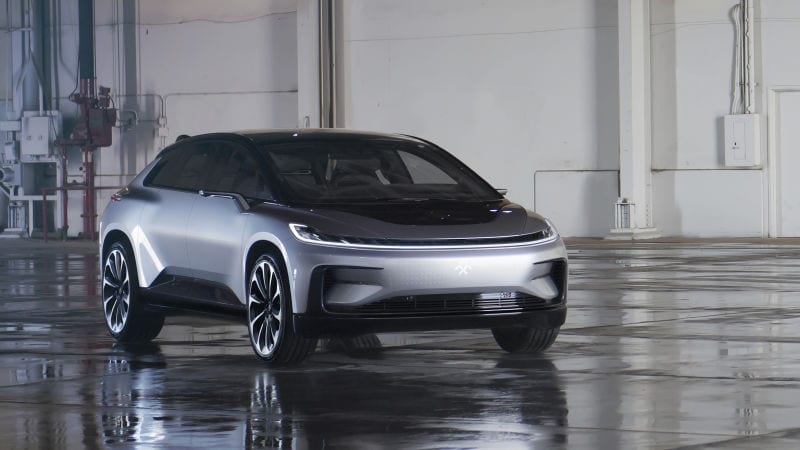
Faraday Future unveils its FF91 at the CES 2017 in Las Vegas. The FF91 presented great gimmicks but Tesla Killer it ain’t. In all fairness, the company claims that the vehicle is a production model, but it yet has to deliver a single working version as the two cars presented to the media were only Beta versions. The company’s demonstration also went horribly wrong and removed the video of it and replaced it with an edited version. Fortunately the original has been downloaded by various media outlets for posterity. Follow the link for the alternative reality as opposed to the company’s reality below.
Ford’s electric vehicle program announced this week, although sounding impressive, falls short of delivering a punch for the sector. The company unveiled seven electrified models to reach the market in the next five years with a further six to follow. The automaker will also invest $700 million in upgrading their Michigan plant for electric and autonomous vehicle production, adding 700 direct new jobs. The press release clearly aims to impress President Donald Trump as the company also scuttled plans for a $1.6Bln plant in Mexico. The reason why we see Ford’s announcement as underwhelming is that the company is clearly just towing the line according to regulations since all the model’s bar one would be plug-in hybrid’s, a trend which has surely run its course. Die hard Ford enthusiast would be happy with PHEV versions of the Mustang, F-150, a hybrid autonomous model, two police vehicles and Transit Custom taxi/delivery van. The only Battery Electric Vehicle is a Small Utility with a range of 300 miles.
ChargePoint, a manufacturer of charging stations and adapters unveiled a water-cooled 400kW DC fast charger, the Expres Plus at the 2017 CES in Las Vegas this week. The Express Plus would be available from mid-2017 in both CCS and CHAdeMOstandards and would add 100 miles range in just 15 minutes. To put the significance in perspective automakers qualify ultra-fast chargers from 350kW and above, with Tesla‘s industry-leading supercharger being 145kW.
KPMG’s 2017 Global Automotive Executive Survey leaves us dumbfounded as an overwhelming number of executives still see Battery Electric Vehicles fail and Fuel Cells to be the real deal. The report, however, identifies Battery Electric Vehicles as the key trend up to 2025 as regulatory pressure pushes awareness of the technology. A telling figure though is that amongst downstream players, such as auto dealers, Battery Electric Vehicles are second only to connectivity and digitalization, again proving the reluctance of dealers to push the technology.
An Illinois-based start-up Rivian Automotive moves into old Mitsubishi plant which it closed with a full loss of employment opportunities to the Normal County in 2015. The newcomer hopes to invest $175 million in developing electric and autonomous vehicles which would create employment opportunities for 1,000 people. Rivian announced that it would unveil its first model later this year and start production in 2019.

Ford debuted it’s next-generation Fusion Hybrid Autonomous development vehicle this week. The second generation of the vehicle sports more production ready controls and LiDar sensors on top of an improved computer hardware platform. Improved field of vision on the sensors allowed Ford to have only two sensors as opposed to four in the first generation. The second generation follows the first, introduced three years ago. The company aims to have an SAE Level 4-capable vehicle commercially available by 2021 for ride-hailing and sharing purposes. Ford will also expand its test fleet, currently operational only in California to its home state, Michigan.
Lamborghini, a Volkswagen company, announced this week that it plans to include a PHEV version of its first SUV since the LM002, the Urus when its released in 2018. The auto manufacturer is also rumored to work on an all-electric vehicle, named the Vitola, which will use the Porsche Mission E platform.
The controversial LeEco announced the groundbreaking of its plant in the city of Hangzhou, Zhejiang Province China. LeEco is entwined between Faraday Future and the LeSee electric vehicle manufactured by LeEco. Both companies were founded by Chinese businessman Jia Yueting. Both businesses are known for making bold statements and big ticket announcements just to be followed by press reports of cash flow and funding problems. The announcement comes at a time when Faraday Future is battling to break ground on its plant in Northern Los Angeles. The company could not even pay the $21 million deposit to Aecon despite being offered $300 million by the local authorities for building the assembly plant there. LeEco has also partnered with Aston Martin on the RapidE, where it will help with the development of the zero emission technology. Faraday Future is said to hold the patents to the technology, but recent reports state that the technology is in fact held by a separate company in the Cayman Islands, creating insecurity for investors and borrowers..
In another attack on Tesla by the old guard, as the State of Missouri rejected its dealership license renewal. The reason being a ruling by Circuit Judge Green in a case brought against the Missouri revenue department by the Missouri Auto Dealers Association for allowing the license in 2015. Tesla prefers to use a direct sales model due to the notorious inability of traditional dealers to sell electric vehicles. Tesla will be forced to close shop in the State come January the 1st 2017.
Miners are scrambling for “modern” resources such as lithium, nickel, and cobalt used in the electric vehicle manufacturing process. A reporter, Marcus Le Roux explored the various metals and their potential supply constraints and sources in the Australian. Most interestingly are the place which copper plays within the electric vehicle industry and the expectation that current lithium demand would rise from 16,500 to between 120,000 to 250,000 tons by 2025 to feed the 14 battery mega factories that are developed, mainly in China.